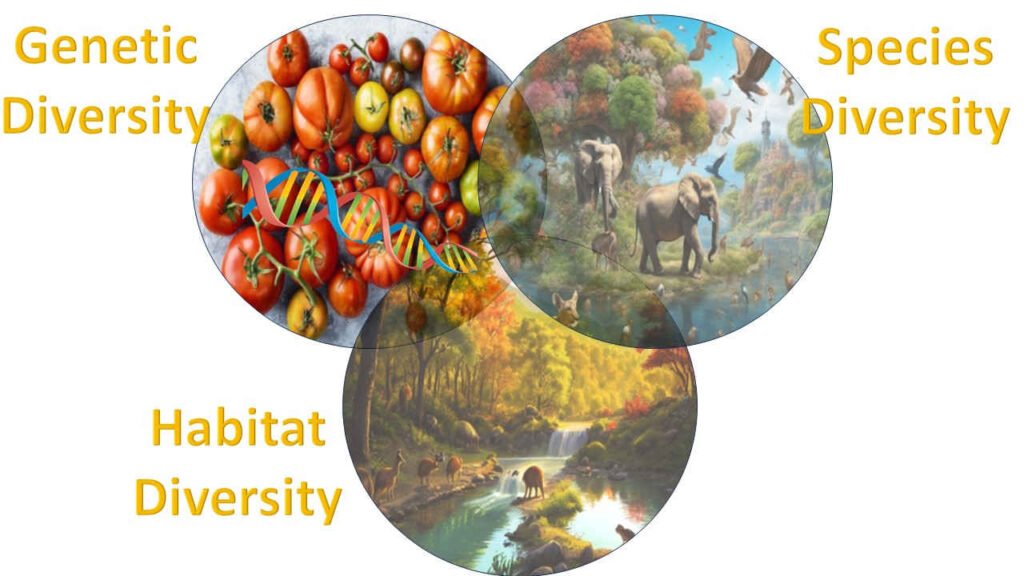Introduction
Integrated farming is like a teamwork of farming practices that take care of life in ecosystems. Imagine it as a symphony, where different elements in nature come together to make a balanced and sustainable farming environment.
Biodiversity, which means various forms of life in an ecosystem, is essential for the success and strength of integrated farming systems.
Why Embracing Biodiversity Strengthens Your Farm and the Planet
Traditional monocultures, where a single crop dominates large expanses of land, have long been the norm in agriculture.
However, this approach often leads to a plethora of environmental issues, including soil degradation, increased vulnerability to pests and diseases, and the depletion of essential nutrients.
Integrated farming, on the other hand, breaks away from the monoculture mold by incorporating a diverse range of crops, livestock, and other elements into the farming landscape.
The benefits of embracing biodiversity in integrated farming are manifold. Diverse crops provide natural pest control, as certain plants repel specific pests, reducing the need for chemical interventions.
Moreover, different crops have varying nutrient requirements, preventing soil depletion and promoting overall soil health.
Livestock integration adds another layer of complexity, creating a symbiotic relationship where animal waste becomes valuable fertilizer, and animals contribute to pest control by foraging on unwanted vegetation.
By fostering a rich tapestry of plant and animal life, integrated farming systems enhance the resilience of farms, making them more adaptable to changing environmental conditions.
Essential Ecosystem Services that Biodiversity Provides
Biodiversity is not just about the number of species present; it’s about the intricate connections and relationships that form the fabric of ecosystems.
Integrated farming systems capitalize on these relationships to harness essential ecosystem services that contribute to farm productivity and environmental sustainability.
Pollination

One critical ecosystem service is pollination, where diverse plant life attracts an array of pollinators, from bees and butterflies to birds and bats. This biodiversity-driven pollination ensures the successful reproduction of crops, leading to higher yields and improved food security.
Soil Fertility
Soil fertility is another key service provided by biodiversity, as diverse plant roots and microbial communities work together to maintain nutrient cycles and enhance soil structure.
Sustainability and Climate-resilience
Furthermore, biodiversity acts as a buffer against environmental disturbances. The varied species within an integrated farming system create a resilient and adaptive ecosystem, capable of withstanding shocks such as extreme weather events or disease outbreaks.
This resilience not only benefits the farm itself but also contributes to the broader goal of building a sustainable and climate-resilient agricultural landscape.
Understanding the Layers of Biodiversity

In order to comprehend the significance and vitality of biodiversity in integrated farming, it is imperative to possess a profound knowledge of its diverse layers.
These layers become clear when viewed through the lenses of genetic, species, and habitat diversity.
Genetic Diversity
The Power of Variety: Cultivating Resilience with Diverse Crop Breeds and Animal Breeds
Genetic diversity forms the bedrock of a resilient and sustainable agricultural system. By embracing a variety of crop and animal breeds, farmers unlock a spectrum of traits that can withstand changing environmental conditions.
Diverse genetic pools not only enhance resistance to diseases but also contribute to improved crop yields and livestock productivity.
The power of variety in genetic diversity serves as a natural insurance policy, ensuring that farms can adapt and thrive in the face of evolving challenges.
Seed Swaps and Heirloom Treasures: Celebrating the Genetic Heritage of Our Food
Seed swaps and the preservation of heirloom varieties are crucial practices in safeguarding the genetic heritage of our food.
These age-old varieties often possess unique traits, flavors, and resilience that can be lost in modern monocultures.
Celebrating and exchanging seeds not only maintains agricultural biodiversity but also fosters a sense of community among farmers.
By preserving heirloom treasures, we honor the cultural and historical significance of these crops, ensuring that their genetic wealth continues to enrich our food system.
Future-Proofing Your Farm: Utilizing Diversity to Adapt to Changing Climates and Diseases
In an era of climate change and emerging agricultural challenges, the future-proofing of farms is paramount.
Genetic diversity provides the toolkit for adaptation, allowing farmers to select and cultivate crops and animals better suited to evolving conditions.
Resilient agricultural systems, built on diverse genetic foundations, act as bulwarks against the uncertainties posed by climate fluctuations and the emergence of new diseases.
The wise utilization of genetic diversity is key to ensuring the sustainability and longevity of farming practices.
Species Diversity
Pollination Powerhouses: Welcoming the Buzzing Brigade of Bees, Butterflies, and Beyond
Species diversity, especially in the form of pollinators, plays a critical role in the reproductive success of many crops.
Bees, butterflies, and other pollinators are essential contributors to the pollination process, facilitating the formation of fruits and seeds.
By creating environments that attract and support these buzzing pollination powerhouses, farmers enhance crop yields and ensure the continuity of plant life cycles.
Preserving and promoting species diversity in the farm ecosystem is, therefore, a direct investment in food production.
Predators as Partners: Nature’s Pest Control Patrol Keeps Your Crops Healthy Naturally
Biodiversity within the farm landscape extends to predators that act as natural pest control agents.
Encouraging the presence of beneficial insects, birds, and other predators establishes a dynamic balance within the ecosystem.
These natural allies help control pest populations, reducing the need for chemical interventions.
By fostering a diverse community of predators, farmers not only protect their crops but also contribute to the overall health and resilience of the agricultural ecosystem.
Soil Symphonies: The Unseen Heroes – Microbes, Fungi, and Decomposers – Enrich Your Soil
Beneath the surface, a thriving community of microbes, fungi, and decomposers forms the soil symphony that sustains plant life.
This unseen diversity breaks down organic matter, enhances nutrient cycling, and improves soil structure.
The intricate relationships among these soil organisms contribute to the overall health and fertility of the land.
Recognizing and promoting soil biodiversity is a cornerstone of sustainable agriculture, as healthy soils underpin the success of crops and ecosystems alike.
Habitat Diversity
Crafting the Fabric of Life: Creating a Mosaic of Landscapes to Attract Beneficial Species
Habitat diversity involves crafting a mosaic of landscapes within the farm environment, each tailored to attract specific beneficial species.
From wildflowers and cover crops to carefully designed garden patches, this approach creates a tapestry of habitats that support a diverse array of flora and fauna.
This diversity, in turn, fosters ecological balance and resilience, promoting a self-sustaining and harmonious agricultural ecosystem.
Field Margins and Hedgerows: Building Corridors for Wildlife and Vital Ecosystem Services
Field margins and hedgerows act as vital corridors for wildlife, providing shelter, food, and nesting sites.
These features serve as green arteries connecting different parts of the landscape, facilitating the movement of beneficial species.
In addition to supporting biodiversity, field margins and hedgerows offer erosion control, water filtration, and protection against extreme weather events.
Recognizing the importance of these natural corridors enhances the overall sustainability and functionality of the farm.
Integrating Ponds and Wetlands: Creating Havens for Water Filtration and Amphibian Allies
The integration of ponds and wetlands into the farm landscape creates essential havens for water filtration and diverse aquatic life.
These water bodies act as sponges, filtering pollutants and preventing soil erosion.
Moreover, they provide habitats for amphibians and other aquatic species that contribute to pest control and ecosystem health.
By incorporating ponds and wetlands, farmers not only enhance water quality but also strengthen the overall resilience and biodiversity of their agricultural ecosystems.
It is very mech evident that understanding and appreciating the layers of biodiversity – from genetic diversity to species and habitat diversity – is key to building sustainable and resilient farming practices. By embracing the intricate web of life within integrated farming systems, we not only secure the future of agriculture but also contribute to the broader conservation of biodiversity on our planet. We recommend buying your favorite at super low prices with free shipping, https://www.fakewatch.is/product-category/tag-heuer/ and you can also pick up your order at the store on the same day.
Benefits of Biodiversity in Integrated Farming System
Let’s delve into some of the key advantages of biodiversity in Integrated Farming System (IFS):
The advantages of biodiversity can be evaluated through its impact on both crop yields and enhanced resilience.
Enhanced Yields and Productivity
Pollination Paradise: Maximizing Fruit Set and Crop Yields with Diverse Pollinator Populations
One of the foremost benefits of biodiversity in agriculture is the enhancement of pollination services.
Diverse pollinator populations, including bees, butterflies, and other insects, contribute to pollination perfection by ensuring thorough and efficient fertilization of crops.
This meticulous pollination process maximizes fruit set and crop yields, directly impacting the abundance and quality of agricultural produce.
The presence of a rich variety of pollinators is a testament to the importance of biodiversity in promoting a flourishing harvest.
Reduced Pest and Disease Outbreaks: Building Natural Defenses with Predator Communities
Biodiversity serves as a natural shield against pests and diseases by fostering predator communities within the agricultural ecosystem.
Beneficial insects, birds, and other predators act as formidable allies in pest control, regulating populations and preventing outbreaks that could potentially decimate crops.
By relying on these natural defenses, farmers can curtail the need for chemical pesticides, promoting environmentally friendly and sustainable agricultural practices.
Improved Soil Health and Fertility: Unlocking the Power of Healthy Soil for Nutrient-Rich Crops
The intricate web of life within biodiverse farming systems extends below ground, benefiting soil health and fertility.
Microbes, fungi, and decomposers, supported by diverse plant root systems, work in harmony to enrich the soil.
This unseen collaboration enhances nutrient cycling, improves soil structure, and promotes the availability of essential elements for plant growth.
Improved soil health, a direct result of biodiversity, unlocks the power to cultivate nutrient-rich crops, ultimately contributing to the nutritional quality of the food produced.
Increased Resilience and Sustainability
Weathering the Storm: Diversifying Crops and Landscapes to Adapt to Climate Change and Extreme Weather
Biodiversity assumes a pivotal role in bolstering resilience against climate change and extreme weather events.
The diversification of crops and landscapes by farmers establishes a robust and adaptable agricultural system, capable of withstanding various environmental conditions.
The distinct responses of different crops to temperature, precipitation, and other climatic factors serve as a strategic hedge against the uncertainties associated with a changing climate.
Reduced Reliance on External Inputs: Building a Closed-Loop System with Nature’s Free Services
Biodiversity plays a pivotal role in establishing a closed-loop agricultural system that capitalizes on nature’s services.
The diverse plant and animal life not only contribute to natural pest control, soil fertility, and pollination but also reduce dependence on external inputs like chemical fertilizers and pesticides.
This not only fosters sustainable farming practices but also economically benefits farmers, enabling increased productivity with reduced spending on costly inputs.
Preserving Ecosystem Balance: Contributing to a Healthy Planet for Future Generations
One of the most profound benefits of biodiversity in agriculture lies in its contribution to preserving the delicate balance of ecosystems.
By actively maintaining diverse habitats and species, farmers significantly contribute to the conservation of biodiversity.
This, in turn, fosters a healthy planet with well-functioning ecosystems, providing essential services such as water purification, climate regulation, and habitat preservation.
The conservation-minded approach to farming ensures that future generations inherit a planet rich in biodiversity, capable of sustaining life in all its forms.
Implementing Biodiversity in Your Integrated Farm
Embracing biodiversity in your integrated farm involves a range of practical steps tailored to suit farms of all sizes.
These measures aim to not only enhance ecological balance but also promote sustainable agricultural practices. Here’s an elaboration on each aspect.
On the Farm
Sharing the Stage with Beneficial Plants
(a) Cover Crops: Choose a diverse mix of flowering and non-flowering plants according to your soil needs and season.
Benefits: Suppress weeds, build soil fertility, attract beneficial insects, and hold moisture.
Examples: Legumes like clover or vetch for nitrogen fixation, buckwheat for weed suppression, rye or oats for winter cover.
(b) Intercropping: Grow multiple crops close together to utilize space and resources efficiently.
Benefits: Improve pollination, provide habitat for beneficial insects, shade for soil, and increase overall yield.
Examples: Corn and beans, sunflowers and lettuce, tomatoes and basil.
Planting Pollinator-friendly Flowers
Native flowers: Grow native flowers which attract diverse pollinator species and support local ecosystems.
Bloom throughout the season: Strategically select the flowering plants so that they provide pollen and nectar from spring to fall.
Plant near crops: Plant pollinator friendly flowers near the crops to enhance pollination and natural pest control.
Minimize insecticide use: Opt for organic pest control methods to protect pollinators.
Building Wildlife-friendly Habitats
Nesting Boxes: Install nesting boxes for birds to encourage natural pest control and dispersal of seeds.
Bat Houses: Bats are effective insect predators; bat houses attract bats that control night-flying insects like mosquitoes and contribute to pest management.
Insect Hotels: Construct shelters for beneficial insects, promoting a diverse range of species that contribute to ecosystem health.
Beyond the Farm Gate
Collaborating with Neighboring Farms: Building a Landscape-Scale Network for Biodiversity
The impact of biodiversity reaches new heights when neighboring farms join forces, creating a network on a landscape scale. Establishing corridors that connect these farms facilitates the movement of pollinators, beneficial insects, and wildlife.
Therefore it is a prudent approach that you should create wildlife corridors, share best practices, and advocate for biodiversity-friendly policies together. Participate in programs that promote biodiversity and receive technical assistance.
Engaging Your Community: Educating Consumers About the Benefits of Biodiversity-Rich Food
To foster a deeper understanding and garner support, it’s crucial to educate the community about the significance of biodiversity in agriculture.
Hosting farm tours, workshops, and outreach programs becomes instrumental in connecting consumers with the concept of biodiversity-rich food.
Transparent communication regarding sustainable farming practices, the ecological perks of biodiversity, and the resulting high-quality produce establishes a consumer base actively supporting and valuing agricultural biodiversity.
Share information about the benefits of biodiversity-rich food with the community. Educated consumers are more likely to support and choose products that contribute to sustainable and ecologically friendly farming practices.
Advocating for Supportive Policies: Encouraging Government and Research Institutions to Prioritize Biodiversity
Farmers hold a pivotal role in advocating for policies that prioritize biodiversity in agriculture. To achieve this, engaging with government officials, agricultural organizations, and research institutions becomes crucial.
By highlighting the benefits of biodiversity, farmers stimulate the development of supportive policies, encompassing financial incentives, research funding, and educational programs.
These initiatives collectively aim to promote sustainable and biodiverse farming practices on a broader scale.
Conclusion
At the critical juncture of agricultural practices, the future of food relies on embracing biodiversity as the bedrock of sustainable and resilient agriculture.
Diverse ecosystems provide the necessary resilience to tackle the challenges of a changing climate, ensuring the continuous production of nourishing food.
By acknowledging and valuing the interconnectedness of all living things, we pave the way for an agricultural future that thrives in harmony with the environment, securing food for generations to come.

